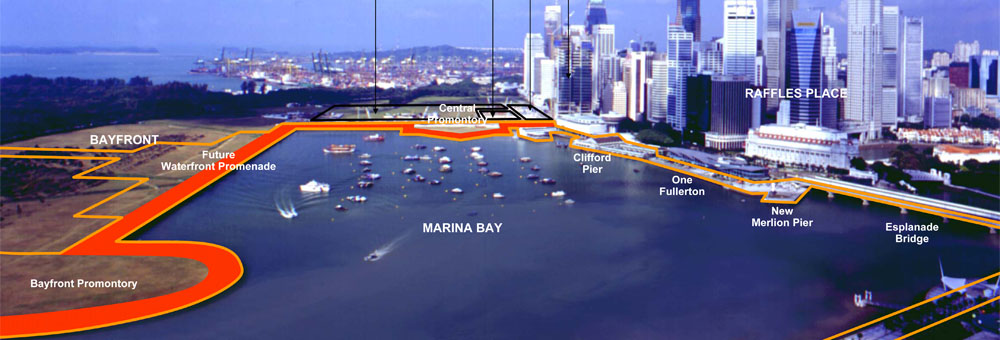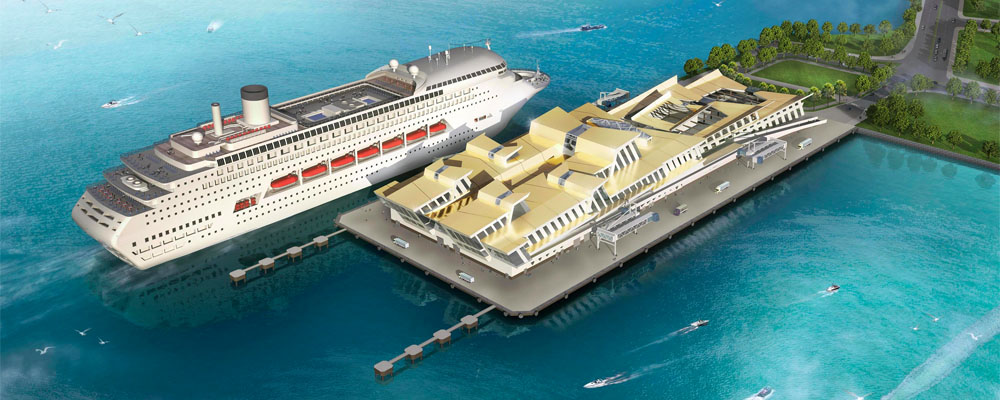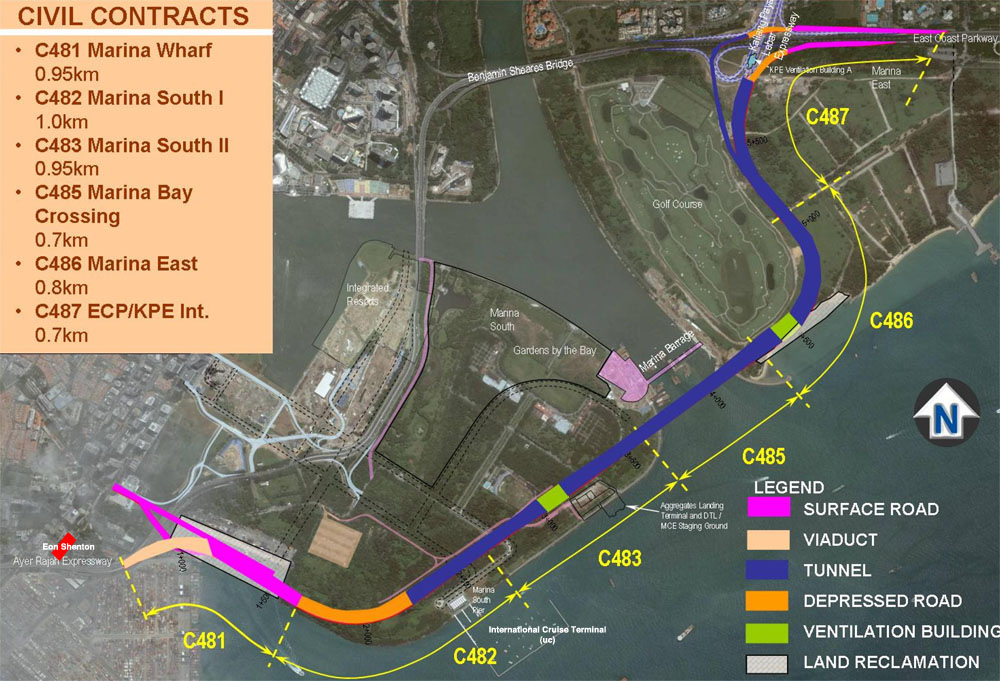Witness Tanjong Pagar Transformation into the next Waterfront City
A Case Study20 April 2012
Marina Bay Waterfront
Less than 10 years ago, the Urban Redevelopment Authority (URA), Singapore's national planning authority called for an International Design Consultancy to secure the best ideas and designs for the waterfront at the Downtown at Marina Bay, Singapore, and eventually appoint Project Consultants to design and supervise implementation of the new 1.5 kilometre (km) waterfront promenade area and 280 metre integrated pedestrian-cum-vehicular bridge at an estimated construction cost of SGD$40 million and SGD$68 million respectively. In this International Design Consultancy for The Waterfront at The Downtown at Marina Bay, Singapore, URA mentioned that The Downtown at Marina Bay will be Singapore's key focus of development in the next 15 to 20 years.
View of Marina Bay from Marina Centre before the development of Marina Bay Waterfront

View of Marina Bay from Raffles Place less than 10 years ago, before the construction of The Float@Marina Bay and Marina Bay Sands.
Today, as URA have envisioned, Marina Bay is a place where opportunities abound. Building atrium with lush greenery, central linear park offering vibrant open space and distinctive garden setting. The development connecting Marina Bay Financial Centre and Raffles Place offer a hub with excellent infrastructure, a global business hub connected to the world, all connected with a pedestrian friendly network. Marina Bay Waterfront today offers spectacular views, day and night with signature skyline and distinctive lighting.

Wonder Full light display at the door steps of the USD$6 Billion Marina Bay Sands Integrated Resort

Artist Impression of the Development at Marina Bay Watefront
International Cruise Terminal

Artist Impression of the International Cruise Terminal currently under construction at Marina South (Rendering by VMW)
Singapore Tourism Board has affirmed its commitment to develop Singapore as a major cruise hub and have showcase the new cruise terminal design for the first time at the Sea Trade Cruise Shipping Convention 2009 in Miami, USA from 17 to 19 March 2009. It was announced in 2008 that Singapore would build a new International Cruise Terminal at Marina South and to double its current cruise handling capacity. On 2 October 2009, STB marked a major milestone in the construction of the ICT bringing Singapore closer to realising its aspiration to be the cruise hub in the region. The ICT will double Singapore's berth capacity and enable more cruise ships to homeport and call on Singapore and Asia is to be completed by the end of 2012. It is designed and built to complement the existing Singapore Cruise Centre at the Southern Waterfront precinct.
This new terminal is expected to meet the project growth of the Asia-Pacific cruise industry, which constitutes about 7 per cent of the world's cruise market today. The region continues to be a vital source of cruise passengers as well as an exotic and desirable destination for avid cruise passengers from the Western markets. On 22 December 2011 STB announced that SATS-Creuers Cruise Services Pte Ltd, a joint venture between SATS Ltd. (SATS) and Creuers del Port de Barcelona S.A. (Creuers), has been appointed the operator for Singapore's International Cruise Terminal (ICT) for a ten-year term and is expected to commence the initial phase of operations in the second quarter of 2012.
Updates: The International Cruise Terminal now named The Marina Bay Cruise Centre Singapore opens on 26 May 2012 welcoming it's first cruise, Voyager of the Seas, the largest cruise ship ever to homeport in Singapore.

Artist Impression of the Aerial View of the International Cruise Terminal (Rendering by VMW)

View of the International Cruise Terminal on Land at Marina South (Rendering by VMW)
Sea-view offices and residential units of Eon Shenton have clear direct view of this land reclaimation and construction currently undergoing way, and when completed will be at the edge of Tanjong Pagar, witnessing the cruise market growth as Singapore poise itself to be a major cruise hub in Asia.
The development of VivoCity, St James Power Station, Harbour Front Centre, HarbourFront Tower and the Residential Projects at Keppel Bay did not just happen. Star Cruise was celebrating 10 years in Singapore back in year 2003, they see the growth and how cruise could be an important appeal in attracting tourists from China and India, and encourgae STB and the government to invest in the cruise industry to transform Singapore into a cruise hub status.
In the same year, PSA divested its non-core businesses and Singapore Cruise Centre Pte Ltd took over the management of Singapore Cruise Centre. North East MRT Line is completed connecting the Cruise Centre with Rapid Transit Access. With the take over, Singapore World Tade Centre was renamed to Harbour Front Centre and the construction work for VivoCity begins.

Singapore Harbour Front then (left) and now (right), it doesn't look like much change, but the surronding changes and how vibrant Harbour Front have become is undeniable.
Economic Strategies Committee
In the Report of the Economic Strategies Committee published in Feb 2010 the ESC mentioned that Singapore will have to refresh and enhance its infrastructure, by revitalising mature residential estates, developing eco-towns, decentralising commercial activity and connecting the island with convenient rail and road networks, so Singapore would be a highly liveable place even as the country grow. The committee have mapped out a whole new waterfront city at Tanjong Pagar, comparable in size to Marina Bay, and planned for the creative use of new underground space, especially around the island's transport nodes.ESC recommends undertaking a masterplan for the progressive development of a new waterfront city at Tanjong Pagar. The committee mentioned in making a strategic shift to a productivity-driven economy, Singapore is required to make bold moves to re-plan its city and recycle land to support new economic activities. A key example is the port land at Tanjong Pagar, Keppel and Pulau Brani. The port's lease at these terminals will expire in 2027. The Government should plan ahead with a view to optimise the value and comprehensively re-plan the prime waterfront land that is freed up. With a land area comparable in size to Marina Bay, this area can be comprehensively master-planned and progressively redeveloped as a new waterfront city with the potential to capture international attention. This will potentially allow for a substantial expansion of the business district, integrated with waterfront housing, hotels, lifestyle and tourism uses. The committee also recommended to study, under the Concept Plan 2011, the feasibility of consolidated port at Tuas in the long term, with adequate handling capacity to ensure continued competitiveness. If feasible, it will increase port efficiency by allowing the port to achieve greater economies of scale in terms of land and operations, and free up existing port land to support new economic activities in the future.
Although the study was not successfully commissioned in Concept Plan 2011 to study the feasiblity of move, we can expect more such details in URA Master Plan 2013. Concept Plan 2011 continued to focus on residential housing needs, maintaing the quality of life and focusing more on Sustainability and Identity after the 2011 General Elections.
Bring Jobs Closer to Home

Artist's impression of the landscaped park above Tanjong Pagar MRT Station looking towards Robinson Road
At a keynote address by Mr Mah Bow Tan, Minister for National Development at the URA Corporate Seminar on 14 April 2011, he mentioned to bring more Jobs closer to Home.
Under Concept Plan 2011, URA will inject more housing in the Central Region and the West Region, where currently there are proportionately more jobs than homes. At the same time, more commercial and industrial activities will be put in the North and North-East, where there are currently more homes than jobs. Re-balancing the job-worker distribution will not resolve all our traffic issues, but it will take some stress off our transport networks and reduce commuting times. This is planned to increase the quality of life and living standards of Singapore.
Eon Shenton is a perfect development supporting this Concept Plan, a mixed development consisting of Residential, Officers and Shops, bring jobs and homes closer than ever. As we see of more residential developments in the Marina Bay Waterfront such as The Sail @ Marina Bay.
Marina Coastal Expressway

Artist Impression of MCE and Construction Progress
The Land Transport Authority (LTA) has begun construction of the Marina Coastal Expressway (MCE)- Singapore's first road tunnel under the sea from April 2009. When completed in 2013, the MCE will serve as a key element of the strategic island-wide road network to support the long-term growth of Singapore, connecting KPE to AYE. The MCE will enhance the current road network to support the projected increase in traffic generated by upcoming development in the Marina Bay and Tanjong Pagar area.
The MCE is a major engineering challenge, especially the section that has to be constructed below the sea. Another challenge will be at the Marina South section of the MCE where tunnel will run above the new North-South Line Extension (NSLe), which is expected to be completed by 2014. As part of the MCE works, the team will construct a 280m section of the NSLe tunnel directly under the MCE tunnel.

Alignment of Marina Coastal Expressway (MCE)
Conclusion
Even as Singapore's iconic Marina Bay nears completion, its next waterfront city has been identified. Looking at the plans and the development that follows for Marina Bay Waterfront, the iconic buildings and the opening of Marina Bay Sands, we are more than certain, Tanjong Pagar Waterfront will be a sucess under the strong leadership of the Singapore Government. The Master Plan 2013 will be something worth looking forward to as details of more land reclamation at Tuas is to be released. Its less than 20 years from 2027 when port operator PSA Corporation's lease on the land at Tanjong Pagar expires, a waterfront development at the location where these port now stand will compliment well the tourism hot spot as the International Cruise Terminal at Marina South welcome the increasing number of cruise visitors. The completion of MCE will connect Tanjong Pagar directly with Changi Airport through ECP bring connection to global cities closer.
This is the view we now see from the 17th floor of Marina House where Eon Shenton showroom is at. Let's us look forward when the land reclaimation at Marina South and the construction of Singapore's International Cruise Terminal completes. The progessive move of PSA port to Tuas. Eon Shenton stand at the edge of the current Tanjong Pagar Development, a perfect location to witness the transformation as Tanjong Pagar becomes the next Waterfront City in the next 20 to 30 years.
© Copyright 2012, JoelGoh.com This case study is prepared by Joel Goh (CEA Registration No.: R043498E) for the website hosted at the domain www.eonatshenton.com.
All rights reserved. He can be reached via email at [email protected]. Photos: URA, LTA, VMW, LaserVision

